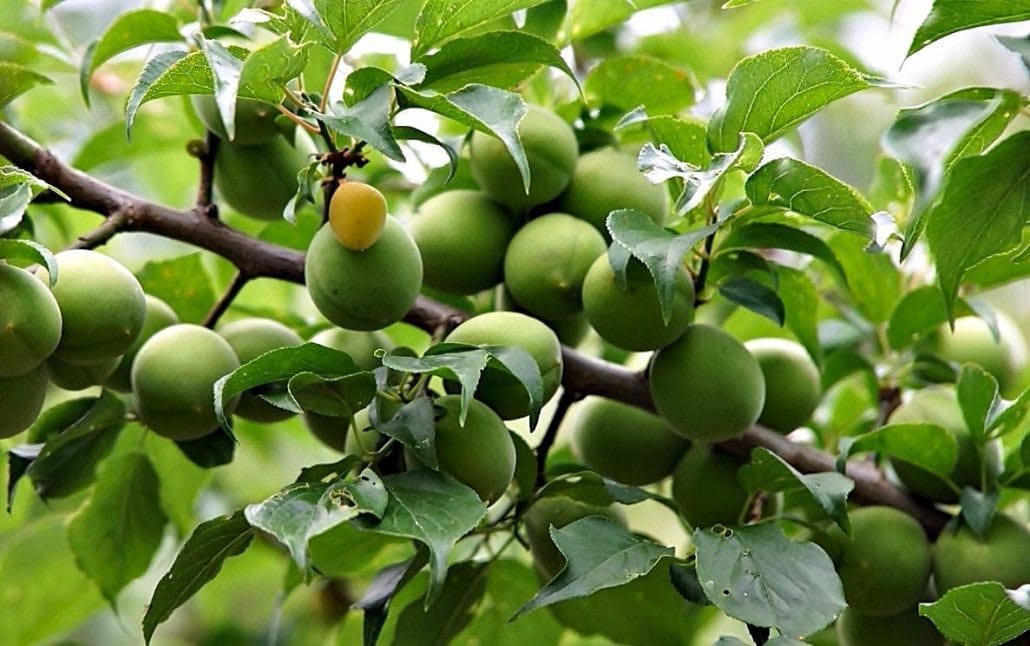Maehwa—Korean for plum blossoms—has always been one of Korea’s most beloved spring flowers. For centuries, maehwa was regarded as a steadfast symbol of winter and a harbinger of spring, frequently depicted in folk art and poetry as a representation of perseverance and hope, beauty and purity, as well as the transitory nature of life.
The maehwa tree is related to both the plum and the apricot. Although it is generally referred to as ‘plum’ in English, it is more closely related to the apricot. The fruit of the maehwa tree is called maesil. In English, it goes by several names including Korean green plum, Chinese plum or Japanese apricot.
Maesil is commonly consumed in many parts of Asia, including Korea, Japan and China. The green plums—called ‘cheong-maesil’ in Korean—are firm and tart, ideal for pickling and for making maesil-cheong (plum syrup). It has long been used in traditional medicine in the East, known to cure common ailments such as indigestion and diarrhea.

Throughout the months of May and June, when the green plums come into season, restaurants and local households alike purchase them in bulks to prepare pantry staples to be consumed throughout the year. Maesil-cheong is an anti-microbial syrup made by sugaring the green plums. In Korea, maesil syrup is used as a condiment and sugar substitute in salad dressings, all manner of marinades and sauces. It is also diluted in hot water to be consumed as tea or mixed in with cold water to be enjoyed as a refreshing summertime beverage.
To make the syrup, equal parts whole maesil and sugar are packed into an air-tight jar and left for up to three months as the fruit slowly releases its juices. Once the syrup is ready, the fruit is removed from liquid. Leaving the fruit in will add a pronounced tartness to the syrup–not a bad thing–but its removal is advised for those that prefer the sweet essence without the tartness. The syrup can either be consumed right away or left to mature for up to a year or even more for an enhanced depth of flavor. Once removed from the liquid, the shriveled fruit need not be discarded as Koreans often preserve them in gochujang or fermented chili paste to make maesil-jangajji or pickled green plums, a sweet and salty, spicy and tart side dish.

‘Hwang-maesil’, which literally means ‘yellow plums’, refers to the soft ripe maesil. Do not be deceived by their color, for even the yellow ones are nowhere sweet enough to be enjoyed raw. Although green plums are commonly used to flavor alcohol, the yellow plums are a better choice for making maesil-ju or plum liquor, a sweet, slightly tart and smooth alcoholic drink made by steeping maesil in soju. It is a popular drink in Korea marketed under various brand names.
************
Maesil-Cheong (Green Plum Syrup)
Ingredients: 1 kg of maesil, 1 kg of sugar (white or brown)
- Wash maesil thoroughly and dry the surface.
- In a sterilized jar, alternate layers of whole maesil and 80% of the sugar.
- Cover the top layer completely with the remaining sugar.
- Seal the jar. Store it in a dry cool area for up to 3 months.
Maesil-Jangajji (Pickled Green Plums)
Ingredients: 1 kg of maesil, 1 kg of sugar, gochujang
- Cut maesil vertically into quarters. Remove kernel.
- In a sterilized jar, alternate layers of maesil and sugar. Make sure to cover the top layer with enough sugar so that the fruit is completely covered.
- Leave in a cool dry area for two weeks.
- Separate fruit from the liquid.
- Dry the fruit in a cool dry area for 24 hours.
- Bury the semi-dried fruit in gochujang. The jangajji will be ready in a month.
- When serving, scrape off most of the gochujang from the maesil. Drizzle with sesame oil and serve.
Versatile Maesil Soy Sauce
Ingredients: 1.5 cups of soy sauce, 1 cup of maesil syrup, 0.5 cup of rice wine, 30 g of green onion, 20 g of minced garlic, 20 g of minced ginger, 2 pieces of dried red chili pepper
- Mix all the ingredients together and bring to a boil.
- Strain liquid.
- Transfer the sauce to a jar and refrigerate for up to a month.
Published 2017.06.13






















